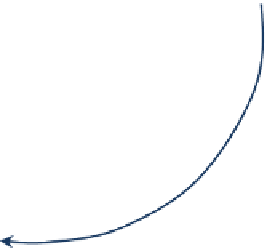Biomedical Engineering Reference
In-Depth Information
metabolizing fatty acids. In some microbes, PEP can be combined with CO
2
to yield oxalo-
acetate. Three enzymes that can catalyze such a conversion have been found (PEP carbox-
ylase, PEP carboxykinase, and PEP carboxytransphosphorylase). Pyruvate can be combined
with CO
2
to yield heterotrophic CO
2
fixation can be an important factor in culturing
microbes. When a culture is initiated at low density (i.e. few cells per unit volume) with
little accumulation of intracellular CO
2
, or when a gas sparge rate into a fermentation
tank is high, then growth may be limited by the rate of CO
2
fixation to maintain the TCA
cycle.
Figure 10.25
shows a schematic of the glyoxylate cycle, which is nearly a variant of the
TCA cycle. Glyoxylate cycle is an anabolic metabolic pathway occurring in plants and several
microorganisms, such as E. coli and yeast. The glyoxylate cycle allows these organisms to
synthesize carbohydrates. Fatty acids from lipids are commonly used as an energy source
by vertebrates via degradation by
b
-oxidation into acetyl-CoA. This acetate bound to the
active thiol group of coenzyme-A enters the citric acid cycle (TCA cycle) where it is fully
oxidized to carbon dioxide. This pathway thus allows cells to obtain energy from fat. To
utilize acetate from fat for biosynthesis of carbohydrates, the glyoxylate cycle, whose initial
reactions are identical to the TCA cycle, is used.
COO
-
i
COO
-
i
HC
OH
HC OH
H
2
O
-
OOC C
Hw
-
OOC CH
w
H
2
O
CH
2
h
CH
2
h
COO
-
Aconitate
COO
-
Iso-citrate
H
OH
-
OOC CH
2
CCH
2
COO
-
WO
COO
-
Citrate
COO
-
I
CH
2
w
-
OOC CHO
Glyoxylate
CH
2
h
FAD
COO
-
Succinate
CoA
FADH
2
H
2
O
Acetyl CoA
Acetyl CoA
-
OOC CH=CH COO
-
Fumarate
CoA
-
OOC CO CH
2
COO
-
Oxaloacetate
H
2
O
COO
-
i
NADH
HO
C
H
O
HCH
w
NAD
+
COO
-
Malate
FIGURE 10.25
The glyoxylate cycle.





























































Search WWH ::

Custom Search